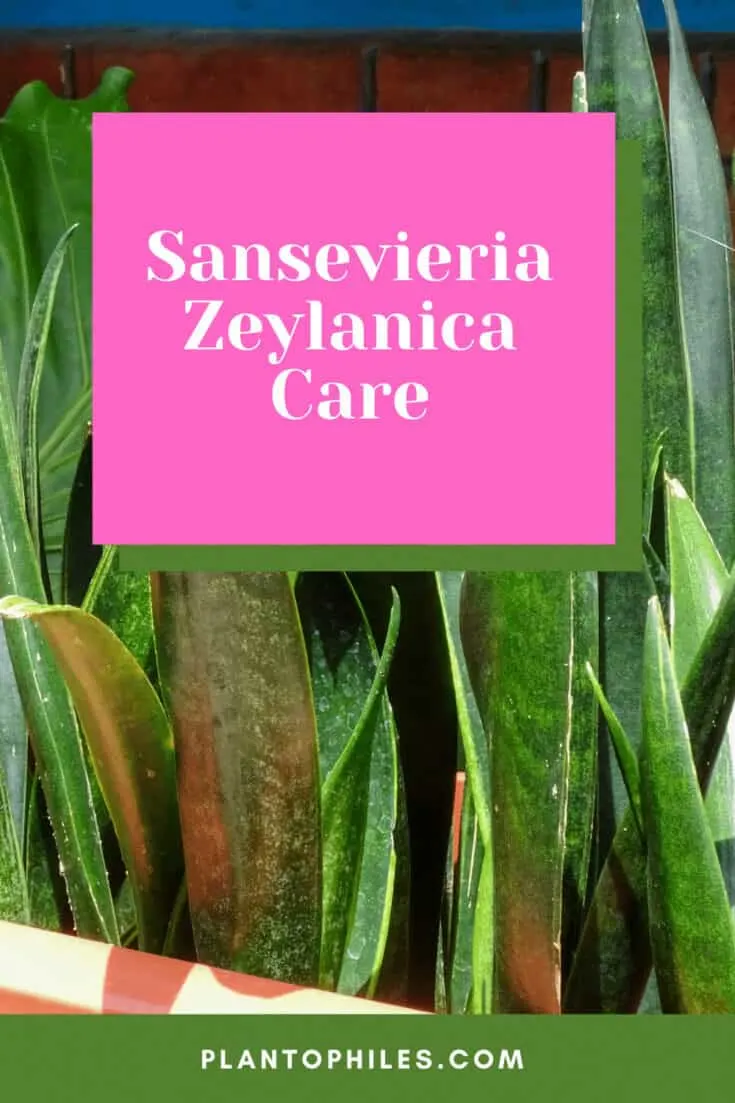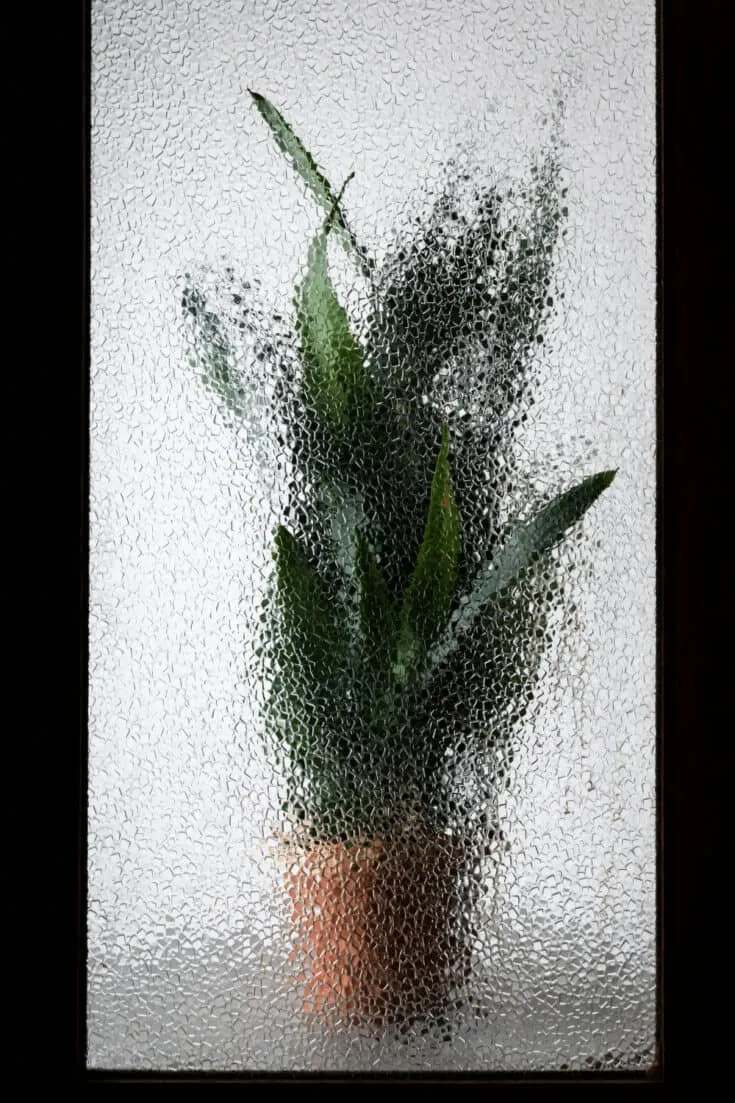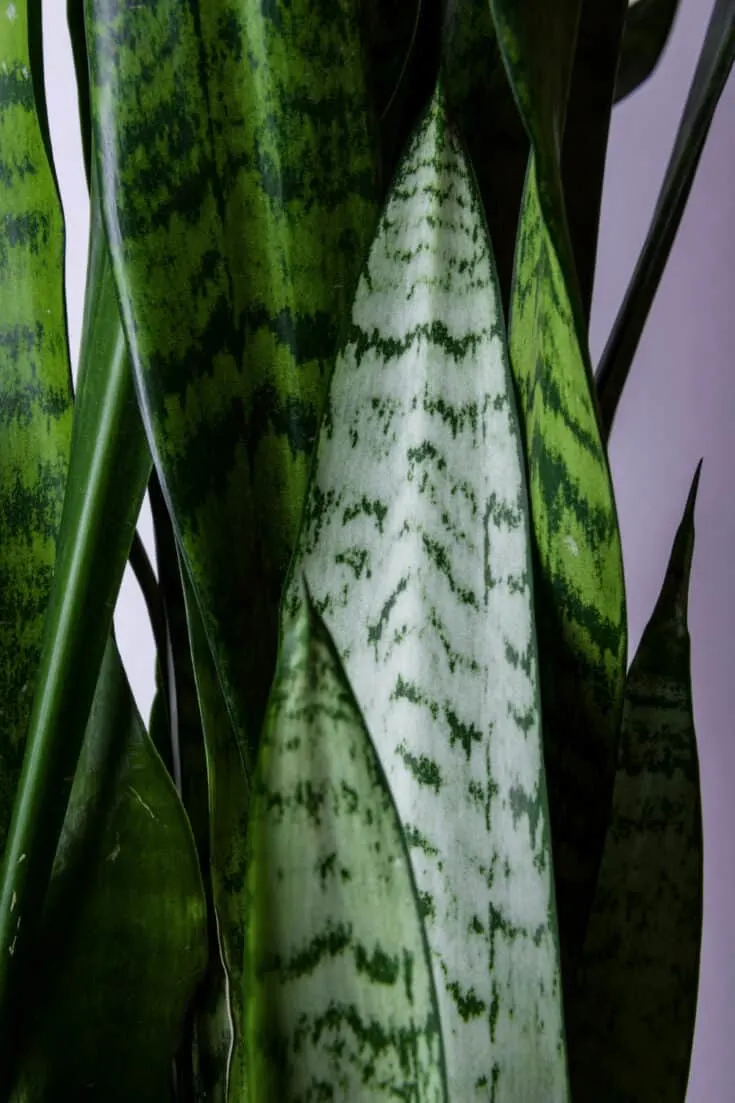Belonging to the Dracaena genus, the Sansevieria zeylanica is a perennial succulent.
As the University of Florida states, the most plants sold as x are actually Sansevieria trifasciata.
This evergreen plant is better known as Sansevieria Indica, Snake Plant, or Bowstring Hemp.
Tough and rugged-looking, the Sansevieria zeylanica is commonly found is in dry, rocky areas.
The Bowstring Hemp is native to Southeast Asia and the tropical regions in West Africa. It has long, erect leaves with pointy tips. This is a hardy, tough plant that often features rough, brown edges
The sword-shaped leaves of the Sansevieria zeylanica flaunt a beautiful olive-green coloring with pale green stripes.
These stripes are wavy and run horizontally along with the plant’s leaves.
There are several other exciting Sansevieria such as the Stuckyi and the Fernwood.
Sansevieria zeylanica Care
To care for Sansevieria zeylanica use well-draining soil using a coarse and sandy succulent potting mix and bright indirect light. It will tolerate lower light levels. Water bi-weekly in spring and summer and reduce to once a month in autumn and winter. A humidity of 40% is sufficient. Fertilize monthly in spring and summer.

Sansevieria zeylanica Care
Sansevieria zeylanica Care Guide
Soil
Sansevieria zeylanica grows best with soil that is well-draining. It is not tolerant of soggy soil.
The Sansevieria zeylanica can adapt to many different types of potting soils, provided they have good drainage.
A granulated and coarse soil mix is the best option for your snake plant. It is recommended to use a sandy loam succulent potting mix.
Light
Sansevieria zeylanica grows best in bright indirect light but will tolerate lower light levels.
This succulent is unlike others as it is capable of surviving in low light.
Sansevieria zeylanica is happy to adapt to various levels of light.
From partial shade to intense sunlight, this plant can handle.
Tolerance to these levels of light does not mean they will do their best in them.
Your Bowstring Hemp needs a moderate amount of bright light in order to grow properly.
Keeping your Sansevieria zeylanica in very low light will result in leaves of a more dull color.
When exposed to intense or full, direct sun, the edges of your plant’s leaves are likely to turn yellow.
The ideal condition for your Bowstring Hemp to thrive is to put it in moderate to bright, indirect, or filtered light.
You will notice brighter, more vibrant coloring in your plant’s leaves when in its preferred location.

Sansevieria zeylanica Care prefers bright indirect light but will tolerate lower light levels
Watering
The Sansevieria zeylanica is a very drought-tolerant plant. It requires a minimal amount of water. Infrequent watering is best, usually, once every other week in spring and summer will suffice.
During the colder, winter months you should water your Bowstring Hemp sparingly.
When its growing season arises you should provide your Sansevieria zeylanica with a decent amount of water.
The active growing season for this plant occurs in the spring and summer months.
You should only water your plant once its soil has dried completely.
One deep watering is the recommended method of watering your Bowstring Hemp.
Succulents store water in their leaves and should never have soggy soil.
Overwatering your Sansevieria zeylanica is a sure way for it to suffer from root rot.
It is always best to check your plant’s soil is dry before watering.
Rather than overwatering, the Bowstring Hemp would prefer to be left without water for an extra day or two.

Sansevieria zeylanica Care only needs a watering every other week in spring and summer and once a month in autumn and winter
Temperature
Sansevieria zeylanica grows best in a temperature between 60°F to 75°F (15°C to 24°C).
The Sansevieria zeylanica, originating from drier areas, is more comfortable in warmer temperatures.
The average room temperature is good. Ideally, temperatures between 60°F to 75°F (15°C to 24°C) will keep your Bowstring Hemp happy.
This plant is not tolerant of extreme temperatures.
Leaf damage will start to occur if your Sansevieria zeylanica is left in temperatures of 50°F (10°C) and below.
To protect your Bowstring Hemp, it is best to keep it out of the line of drafts.
Humidity
40% of humidity is sufficient for Sansevieria zeylanica.
Semi-arid to humid climates and environments are what this plant likes best.
If your Sansevieria zeylanica is in a pot indoors, it does not need any extra humidity.
Things like pebble trays or humidifier to increase the humidity are reserved for tropical jungle plants.
Fertilizer
Fertilize Sansevieria zeylanica once a month in spring and summer using a general-purpose fertilizer.
Sansevieria zeylanica’s feeding habits are minimal.
They are low maintenance and supplementary feeding is not required.
Giving your plant too much fertilizer will make its leaves fall over.
Fertilizing your Bowstring Hemp only needs to be done once a month at most.
This should just be done during the growing season.
A general-purpose houseplant or cactus feed will do the job.
Propagation
Propagating your Sansevieria zeylanica can be done by dividing rhizomes and leaf cuttings.
There are a few viable methods available to choose from.
Using rhizomes from your plant is an option. Easier still, propagation is also easily done by leaf cuttings or even division.
Growth
The beautiful Bowstring Hemp is evergreen and grows during the summer to spring seasons. It grows to heights between 1.5ft to an ultimate 3.3ft (45cm to 1m).
The Sansevieria zeylanica is a blooming plant. Although rare, it blossoms between the months of winter and spring.
Flower stalks of the Bowstring Hemp grow tall like its leaves and can grow to over 2ft (61cm).
Although it is a slow-growing plant, the Sansevieria zeylanica is easy to grow.
They are known to grow well even when experiencing minimal care.
This easy-goer doesn’t even require regular pruning. It is only necessary if your plant develops dead or damaged leaves.
The leaves of the Bowstring Hemp feature intricate horizontal zebra stripes. It is a stemless plant that commonly suffers from very minor leaf cracks.
Reaching about 1inch (2.5cm) wide, the Sansevieria zeylanica leaves form from a rootstock that is rhizomatous.
On the odd occasion, you get to experience the blossoming of your Bowstring Hemp, you are in for a treat.
Delicate flowers of a tubular shape grow in clusters upon the flower stem. These flowers are lightly fragrant.
Blooming to sizes between 1in and 1.5in (2.5cm and 3.8cm), the flowers are seen in colors of pale green or greenish-white.
Potting
Sansevieria zeylanica plants are suitable for growth in both indoor and outdoor environments.
To keep your plant comfortable, it is best to use a commercial potting mix that is lightweight. Good drainage is essential in both the soil and the pot.
Using a clay pot for your Bowstring Hemp is ideal. In the event that the plant begins to feel cramped or over-crowded, its roots may crack the pot.
Another sign your Sansevieria zeylanica is in need of a pot transplant is the yellowing of its leaves or possibly even leaf loss. This is a result of congestion.
However, is it not often that you will need to repot your Bowstring Hemp.
It is more likely to do well in a more confined pot.
It prefers to be slightly root-bound.
The chances of your plant producing blooms are increased when its roots are slightly more crowded.
Sansevieria zeylanica Propagation
When thinking of propagating your Bowstring Hemp, there are a few methods to choose from.
Although possible, it is not recommended to grow from seeds.
Not only is it difficult to get seeds due to the rarity of this plant blooming, but this method also is not always successful.
By far the easiest way to propagate your Sansevieria zeylanica is from leaf cuttings.
Not only is this a quick and simple method, but it also gives you the ability to get more than one additional plant.
The process of propagating your plant from leaf cuttings starts with a mature and healthy leaf.
This leaf should be cut into pieces of about 2ft to 3ft (5cm to 7.5cm) in length. These Bowstring Hemp cuttings should be given a day or two to dry.
Next, you should dip the cut end of the leaf piece into the water before pushing them into a rooting hormone.
In a potting mix of one part peat and two parts sand that is damp, plant the leaf cuttings.
A cactus potting mix can also be used. Keep your newly planted Bowstring Hemp cuttings in a location with bright, indirect sunlight.
Watering should only be done once the soil with your Sansevieria zeylanica cuttings is nearly dry.
Propagation through division is merely separating your plant into clumps.
This is a process that should be done with a gentle hand. A mature Bowstring Hemp should be used.
The root ball of your plant should divide into two or more different segments. These segments can then be planted in individual pots.
Common problems with Sansevieria zeylanica
Aside from their issue with blooming, the Bowstring Hemp is fairly problem-free.
Provided you do not overwater your plant and keep it out of direct intense light, you are not likely to find a fault with this plant.
It is hardy and forgiving and doesn’t suffer from many pests.
Occasionally your Sansevieria zeylanica may have a few uninvited guests but they are easily dealt with.
The effect of overwatering is root rot. Sansevieria zeylanica does not fair well in excessively wet soil and will contract and rot quickly.
Overwatering isn’t the only issue, poorly draining soil can be the problem.
Tips to keep Sansevieria Zeylanic problem-free
Avoid subjecting your Bowstring Hemp to extreme temperatures.
Left in temperatures lower than 50°F (10°C) and your plant will face damage, specifically to its leaves.
Yellowing of its leaves may occur if you leave your Sansevieria zeylanica in intense, direct sunlight.
Minor pests can be encountered if your Sansevieria zeylanica is left to collect dust. Keeping your plant dust-free will, in turn, keep it pest-free.
It is best to use a soft cloth that is slightly damp and wipe your plant’s leaves.
Steer away from using leaf-shine products, they may cause damage to your Bowstring Hemp.
The biggest tip to keep your Sansevieria zeylanica happy and looking its best is to water it sparingly.
You should only water your plant once the soil has dried out completely.
Frequently asked questions about Sansevieria zeylanica Care
What pests does the Sansevieria zeylanica have?
The Sansevieria zeylanica is not often bothered by pests. On the occasion your plant does get some unwelcomed guests, they are likely to be mealybugs or spider mites. These pests are low-level threats. They are not likely to cause any harm to your Bowstring Hemp.
Is the Sansevieria zeylanica poisonous?
All parts of the Sansevieria zeylanica are mildly toxic to humans as well as pets. If ingested, the poisoning in this plant can cause drooling, mouth irritation, diarrhea, nausea, and vomiting. It is best to keep it out of reach of small children, cats, and dogs.
What is the Sansevieria zeylanica used for?
Aside from landscaping in gardens and decorating in houses, the Sansevieria zeylanica has been used as a fiber plant. Most tropical countries cultivate it for its fibers. The fibers collected are used to make, among other things, coarse cloth, sails, and mats.The Bowstring Hemp has also traditionally been used to treat septic wounds. The rhizomes and roots of the plant are dried and used to make an antiseptic ointment. Thanks to modern research the aqueous extract from the plant have been confirmed to possess antifungal properties.
How do I deep water my Sansevieria zeylanica?
Before watering your Sansevieria zeylanica, the soil should be left to dry completely. Thorough and deep watering is the best way to water your plant. To deep water your plant is simple. You should slowly pour water onto your Bowstring Hemp’s soil. Keep pouring until water starts to drip out of the drainage hole. Allow the water in the pot to drain out thoroughly. Excess water collected in the pot’s saucer should be discarded. Do not let your Bowstring Hemp stand in water or have soggy soil.
How do you tell the Sansevieria zeylanica and Trifasciata apart?
The Sansevieria zeylanica is less common or well-known as the Sansevieria Trifasciata. It is often misrecognized to be this species. These two plants are very similar and are often difficult to tell apart. The best way to tell them apart is to look at their leaves. Although subtle, there is a difference in their leaf patterns. Don’t think less of one or the other though! These two plants are equally as tough and hardy as the other.
Conclusion
It is hard to find a fault with this plant. The Sansevieria zeylanica is both beautiful and forgiving.
With its ability to filter airborne toxins and continue to produce oxygen at night there’s no reason not to want one!
The Sansevieria zeylanica does not need much talking up, it does that all on its own.
Elegantly patterned leaves and extreme tolerance to neglect, this is one of those must-have plants.

Daniel has been a plant enthusiast for over 20 years. He owns hundreds of houseplants and prepares for the chili growing seasons yearly with great anticipation. His favorite plants are plant species in the Araceae family, such as Monstera, Philodendron, and Anthurium. He also loves gardening and is growing hot peppers, tomatoes, and many more vegetables.


